Table of Contents
Introduction
Imagine living in a world where your mind is a battlefield—a place where focus is a fleeting mirage, and every impulse drags you into a vortex of distraction. This is the terrifying reality of Attention-Deficit/Hyperactivity Disorder, or ADHD. Once a condition primarily associated with unruly children, ADHD has now exploded into a full-blown epidemic, affecting millions of adults worldwide. And here’s the most shocking part: our obsession with social media is making it infinitely worse.
What Is ADHD?
ADHD isn’t just a quirky personality trait; it’s a neurological nightmare that hijacks your brain’s ability to focus, control impulses, and regulate emotions. Symptoms of ADHD include restlessness, fidgeting, and a relentless sense of distraction. Those afflicted often find themselves disorganized, forgetful, and perpetually overwhelmed by everyday tasks. Over time, ADHD can dismantle your life, leading to academic failure, chronic job instability, substance abuse, and shattered relationships.
The long-term impact of ADHD is nothing short of catastrophic. Left unchecked, it can trap individuals in a vicious cycle of underachievement, anxiety, and even depression. Imagine a life where you’re constantly derailed by your own mind, never able to realize your true potential.
The Dark Side of Social Media
Social media is a digital drug, and for the ADHD brain, it’s the ultimate trap. With every like, comment, and share, your brain receives a hit of dopamine—the same pleasure chemical that fuels addictions. But here’s where it gets truly disturbing: the way social media manipulates your brain is almost identical to how cocaine does. Yes, you heard that right. Just like cocaine, social media floods your brain’s reward system with dopamine, creating a cycle of craving and reward that’s nearly impossible to break.
Research shows that chronic cocaine use can actually cause ADHD by rewiring the brain’s neural pathways, leading to impaired cognitive function and a relentless need for stimulation. In essence, social media is the digital cocaine of our era, and it’s turning millions into addicts.
The Social Media Explosion
Social media isn’t just a tool; it’s an all-consuming force, especially for today’s adolescents. They spend up to eight hours a day glued to their screens, with social media consuming a significant chunk of that time. But what is this constant digital engagement doing to their minds? The answer is terrifying: it’s breeding a generation of distracted, impulsive, and anxiety-ridden individuals.
For those with ADHD, the pull of social media is even more powerful. The ADHD brain craves stimulation, and social media offers an endless supply. But the more time spent on these platforms, the worse ADHD symptoms become. It’s a feedback loop of distraction and despair, pulling more and more people into its grip.

The Brain’s Struggle with Social Media
During adolescence, the brain is in a critical phase of development, constantly seeking new experiences and rewards. At this time, the brain’s reward system is in overdrive, while the prefrontal cortex—the part responsible for self-control—lags behind. This imbalance is the perfect storm for ADHD, where impulsivity and inattention are magnified.
For someone with ADHD, social media is a siren’s call. Each like, share, and comment delivers a quick hit of dopamine—a momentary pleasure that leaves the brain craving more. But with each hit, the brain becomes more dependent, making it harder to focus on anything else. It’s a vicious cycle, one that’s difficult, if not impossible, to escape.
The Social Void
Adolescents with ADHD often struggle to fit into social circles. They’re the ones who interrupt, fidget, and miss social cues. And in a society that prizes conformity, they’re often marginalized by their peers. So where do they turn? To social media—the one place where they can control their interactions and present a version of themselves that’s more socially acceptable.
But the problems that plague them offline don’t disappear online. In fact, they often get worse. The impulsivity that leads them to blurt out in class also drives them to post inappropriate comments or overshare on social media. The result? A digital persona that’s just as chaotic as their real-life one, now broadcast to the world.

The Family Factor
ADHD is a family affair, often passed down from parent to child. Parents with ADHD may struggle to set boundaries or model healthy social media behavior. The result? A household where screens dominate, and both parent and child are trapped in their own digital worlds.
But it’s not just about screen time. Families dealing with ADHD often experience higher levels of conflict, and for the adolescent with ADHD, social media becomes an escape from the chaos at home. But this escape is just another trap, deepening their addiction and worsening their symptoms.
Breaking Free
The situation may seem dire, but there is a way out. It starts with recognizing the danger that social media poses, especially for those with ADHD. It means setting boundaries, both online and offline, and finding healthier ways to cope with the challenges of ADHD. It’s not easy, but the alternative—continuing down a path of distraction, impulsivity, and addiction—is far worse.
Conclusion
Social media isn’t just a harmless distraction; it’s a powerful force that can reshape our brains, exacerbate mental health issues, and fuel a new epidemic of ADHD. The parallels with cocaine addiction are shocking, and the consequences are just as severe. We’re standing on the edge of a cliff, and the choices we make today will determine whether we fall or find a way to pull ourselves back.
The question is, are we ready to confront the dark side of our digital world, or will we continue to be its unwitting victims?
While ADHD is a psychiatric disorder, it’s not the same as the severe psychiatric conditions often associated with the term, like psychosis or schizophrenia. I’ve explored psychosis in detail in a separate blog, where I discuss how imagination—uniquely human and tied to creativity—may have evolved from dreaming. However, when not properly regulated by higher brain functions, imagination can lead to primary psychosis, a serious mental disorder characterized by hallucinations and delusions. To learn more about how deficiencies in brain control mechanisms can contribute to disorders like schizophrenia, click HERE to read that blog.





